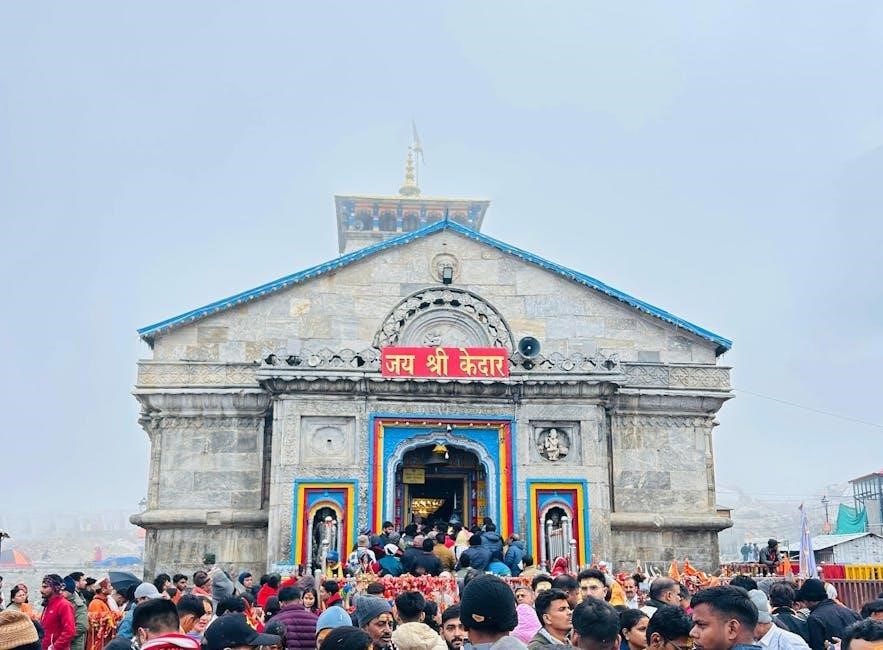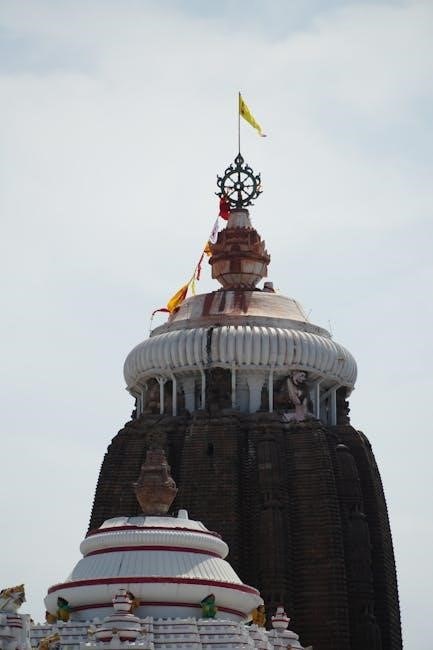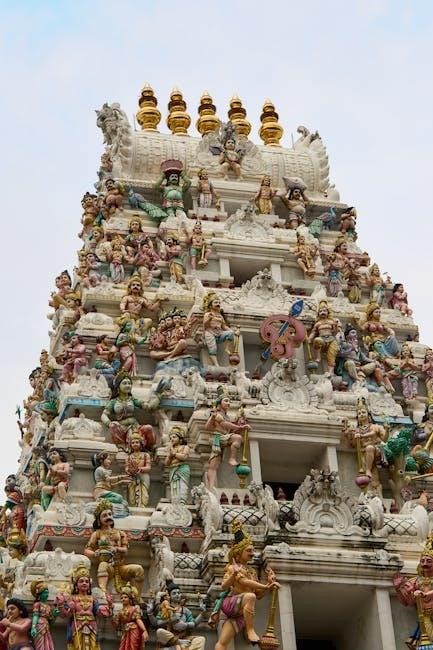vishnu sahasranama in sanskrit pdf
Vishnu Sahasranama is a revered Sanskrit hymn comprising 1000 names of Lord Vishnu‚ embodying divine attributes and spiritual significance. Composed by Maharshi Vyasa‚ it features 108 shlokas‚ offering profound insights into Hindu philosophy. Widely available in PDF format‚ it serves as a sacred resource for worship‚ chanting‚ and spiritual growth‚ preserving ancient wisdom for modern seekers.
1.1 Overview of Vishnu Sahasranama
Vishnu Sahasranama is a sacred Sanskrit hymn containing 1000 names of Lord Vishnu‚ organized into 108 shlokas. Composed by Maharshi Vyasa‚ it is embedded within the Mahabharata‚ highlighting Vishnu’s divine attributes and spiritual significance. This revered text is central to Vaishnavism‚ offering a profound meditation on the Supreme Being. Its availability in PDF format ensures easy access for devotees‚ facilitating daily worship and spiritual growth through chanting and reflection.
1.2 Importance of the Sanskrit Version
The Sanskrit version of Vishnu Sahasranama holds immense spiritual and cultural significance. As the original text‚ it preserves the hymn’s divine essence and phonetic purity‚ essential for chanting. Its intricate structure and meter ensure the correct transmission of meaning‚ making it indispensable for rituals and meditation. The Sanskrit version is considered authoritative‚ maintaining the hymn’s scriptural integrity and its connection to ancient Vedic traditions‚ ensuring its timeless relevance and spiritual potency for devotees worldwide;
1.3 Availability of Vishnu Sahasranama in PDF Format
Vishnu Sahasranama in Sanskrit PDF is widely accessible online‚ offering devotees a convenient way to access this sacred text. Platforms like Ishwar Ashram Trust and Srimatham tradition provide authentic downloads‚ ensuring the hymn’s preservation. The PDF format allows for easy reading and sharing‚ making it a popular choice for spiritual seekers. Digital availability has enhanced its reach‚ enabling global access to this ancient scripture‚ fostering devotion and learning in the modern era.

Origin and Authorship
Composed by Maharshi Vyasa‚ Vishnu Sahasranama is an ancient Sanskrit hymn embedded in the Mahabharata. It holds significant cultural and religious importance‚ particularly in Vaishnavism‚ and remains a revered text for spiritual guidance and worship.
2.1 The Composer of Vishnu Sahasranama
Maharshi Vyasa‚ a revered sage and prominent figure in Hindu scriptures‚ is credited with composing the Vishnu Sahasranama. This ancient Sanskrit hymn‚ embedded in the Mahabharata‚ is a cornerstone of Vaishnavism. Vyasa’s composition is celebrated for its profound spiritual depth‚ detailing 1000 names of Lord Vishnu‚ each encapsulating divine attributes. The hymn’s structure‚ comprising 108 shlokas‚ reflects Vyasa’s mastery in blending devotion with philosophical insight‚ making it a timeless treasure for spiritual seekers.
2.2 The Source Text and Its Significance
The Vishnu Sahasranama originates from the Mahabharata‚ specifically the Anushasana Parva‚ where Bhishma extols Lord Krishna. This sacred text holds immense scriptural authority‚ being integral to Vaishnavism. Its 108 shlokas‚ written in Sanskrit‚ are revered for their spiritual depth and philosophical insights. The hymn is considered a definitive work in Hindu liturgy‚ emphasizing Vishnu’s divine attributes and fostering devotion. Its authenticity and significance make it a cornerstone of Hindu religious and cultural heritage.
2.3 Historical Background of the Hymn
The Vishnu Sahasranama‚ an ancient hymn from the Mahabharata’s Anushasana Parva‚ was composed by Maharshi Vyasa. This sacred text has been a cornerstone of Vaishnavism for centuries‚ revered for its spiritual depth. Over time‚ it has been translated and interpreted‚ yet the original Sanskrit version remains central to its tradition. Its historical significance is undeniable‚ and in the digital age‚ its accessibility through PDF formats has ensured its continued relevance and reach.

Structure and Content
Vishnu Sahasranama contains 1000 divine names of Vishnu‚ organized into 108 shlokas. The hymn is written in Sanskrit‚ preserving its original form and spiritual essence‚ now accessible via PDF.
3.1 The 1000 Names of Vishnu
The 1000 names of Vishnu‚ known as Vishnu Sahasranama‚ are a cornerstone of the hymn‚ each name symbolizing a unique attribute or divine quality of the deity. These names‚ meticulously arranged in 108 shlokas‚ encapsulate Vishnu’s omnipresence‚ compassion‚ and cosmic role. Each name carries profound spiritual significance‚ offering devotees a deeper understanding of Vishnu’s essence. The structure reflects the hymn’s sacredness‚ making it a revered text for worship‚ meditation‚ and spiritual enlightenment.
3.2 The 108 Shlokas in the Hymn
Vishnu Sahasranama is structured into 108 shlokas‚ each containing a set of names that glorify Vishnu’s divine attributes. These verses‚ written in Sanskrit‚ follow a rhythmic pattern‚ enhancing their recitation and spiritual impact. The hymn’s division into 108 shlokas signifies completeness and sacredness‚ making it a foundational text for worship and meditation. Its availability in PDF format ensures easy access for devotees to study and chant these revered verses.
3.3 The Sanskrit Language and Its Preservation
The Sanskrit language is central to Vishnu Sahasranama‚ preserving its spiritual essence and rhythmic beauty. Efforts to digitize the text in PDF format ensure its accessibility while maintaining the integrity of the original script. Organizations like Ishwar Ashram Trust have digitized Sanskrit books‚ including Vishnu Sahasranama‚ to safeguard ancient wisdom. The preservation of Sanskrit ensures that the hymn’s pronunciation and meaning remain authentic‚ fostering its continued relevance in modern times.

Cultural and Religious Significance
Vishnu Sahasranama holds profound cultural and religious significance as a foundational text in Hinduism and Vaishnavism‚ revered for its spiritual depth and ritualistic importance in daily worship practices.
4.1 Role in Hinduism and Vaishnavism
Vishnu Sahasranama is a central prayer in Hinduism‚ particularly revered in Vaishnavism‚ where it is considered a foundational text. It extols Lord Vishnu’s divine attributes‚ emphasizing His role as the preserver of the universe. The hymn is integral to daily worship‚ rituals‚ and spiritual practices‚ serving as a powerful tool for devotion and introspection. Its scriptural authority and profound teachings have shaped Vaishnavite traditions‚ making it a cornerstone of Hindu religious and cultural identity.
4.2 The Hymn’s Place in Daily Worship
Vishnu Sahasranama holds a sacred place in daily worship‚ often chanted during rituals‚ pujas‚ and personal devotion. Devotees recite it to seek blessings‚ peace‚ and spiritual growth. Its availability in Sanskrit PDF formats has made it accessible for daily recitation‚ allowing followers to connect with Lord Vishnu’s divine attributes. Regular chanting is believed to bring mental clarity‚ emotional balance‚ and a deeper sense of devotion‚ making it an integral part of Hindu worship practices.
4.3 Its Influence on Hindu Philosophy
Vishnu Sahasranama profoundly influences Hindu philosophy by elucidating the divine attributes of Lord Vishnu‚ embodying the essence of Vaishnavism. It explores concepts of dharma‚ karma‚ and moksha‚ shaping spiritual thought. The hymn’s emphasis on devotion and divine qualities has inspired philosophical debates and teachings‚ reinforcing the ideals of bhakti and the pursuit of spiritual enlightenment. Its verses remain a cornerstone in understanding Hindu metaphysics and the nature of the divine.
Benefits of Chanting Vishnu Sahasranama
Chanting Vishnu Sahasranama offers spiritual growth‚ mental peace‚ and positive energy. It fosters devotion‚ reduces stress‚ and enhances focus‚ while its sacred names impart divine blessings and protection.
5.1 Spiritual and Mental Benefits
Chanting Vishnu Sahasranama brings profound spiritual and mental tranquility. It fosters inner peace‚ emotional balance‚ and a deep connection to the divine. The hymn’s sacred vibrations reduce stress and anxiety‚ promoting mental clarity and focus. Regular recitation enhances devotion‚ cultivates positive thoughts‚ and strengthens spiritual growth. It also helps in overcoming life’s challenges‚ offering solace and emotional resilience‚ while its rhythmic chanting calms the mind and uplifts the spirit.
5.2 The Power of Each Name
Each name in Vishnu Sahasranama embodies a unique attribute of Lord Vishnu‚ carrying profound spiritual significance. These names are not mere labels but powerful vibrations that connect devotees to the divine. Reciting them with devotion invokes blessings‚ fosters spiritual growth‚ and strengthens the bond with the Almighty. The hymn’s names are believed to ward off negativity‚ bring prosperity‚ and grant inner peace‚ making each name a potent tool for spiritual transformation and divine connection.
5.3 The Role of Chanting in Modern Life
Chanting Vishnu Sahasranama offers solace in today’s fast-paced world‚ reducing stress and fostering mental clarity. Its rhythmic recitation provides a sense of calm‚ helping individuals navigate modern challenges. The hymn’s timeless wisdom promotes spiritual growth‚ making it a valuable practice for seekers of peace and harmony. With its availability in digital formats‚ chanting has become more accessible‚ allowing people to integrate this ancient tradition into their contemporary lifestyles effortlessly.

How to Recite Vishnu Sahasranama
Recite Vishnu Sahasranama with devotion‚ ensuring proper pronunciation and focus. Ideal during early mornings or evenings‚ it requires a calm mind and pure intention for maximum spiritual benefit.
6.1 The Proper Way to Chant the Hymn
Chanting Vishnu Sahasranama requires focus and devotion. Begin with a calm mind‚ ensuring proper pronunciation of each name. Recite slowly‚ maintaining rhythm and concentration. Ideal during early mornings or evenings in a clean‚ peaceful environment. Offer prayers before starting‚ and avoid distractions. Pronounce each syllable clearly‚ as inaccuracies may reduce the hymn’s spiritual impact. Regular practice enhances the experience‚ fostering a deeper connection with the divine.
6;2 The Importance of Pronunciation
Accurate pronunciation is vital when chanting Vishnu Sahasranama‚ as it preserves the hymn’s spiritual potency. Mispronunciation may diminish its effectiveness‚ making it essential to learn from authentic sources. Proper intonation and stress on syllables ensure the names resonate correctly‚ connecting the chanter to Vishnu’s divine energy. Regular practice with guides or tutors helps maintain precision‚ honoring the hymn’s sanctity and maximizing its spiritual benefits.
6.3 Recommended Time and Place for Recitation
For optimal spiritual benefit‚ Vishnu Sahasranama should be recited during auspicious times like early morning (Brahma Muhurta) or evening. A clean‚ quiet‚ and sacred space‚ such as a temple or home altar‚ is ideal. Sitting comfortably on a sacred mat‚ facing east‚ enhances focus. Avoid distractions and maintain purity of mind and environment to deepen the connection with the divine energy of the hymn.
Vishnu Sahasranama in the Digital Age
Vishnu Sahasranama is widely available in PDF format online‚ enabling easy access for devotees. Digital platforms and institutions like Ishwar Ashram Trust have digitized the scripture‚ preserving its sanctity and making it accessible globally for spiritual seekers.
7.1 Availability of PDF Versions Online
Vishnu Sahasranama in Sanskrit PDF is readily available online‚ offering easy access to devotees worldwide. Platforms like Ishwar Ashram Trust and Srimatham tradition provide authentic downloads. These PDFs often include the original Sanskrit text‚ transliterations‚ and translations‚ making them invaluable for both scholars and spiritual seekers. The digital format ensures preservation and widespread dissemination of this ancient hymn‚ facilitating its study and chanting in the modern era.
7.2 Digital Platforms for Download
Vishnu Sahasranama in Sanskrit PDF is accessible through various digital platforms‚ ensuring easy access for global devotees. Websites like Ishwar Ashram Trust and Srimatham tradition offer free downloads‚ providing authentic versions of the hymn. Additionally‚ platforms like www.swami-krishnananda.org and www.prapatti.com host the PDF‚ making it readily available for download. These digital platforms play a crucial role in preserving and disseminating ancient spiritual texts‚ ensuring their availability and accessibility for spiritual seekers worldwide.
7.3 The Role of Technology in Preservation
Technology has significantly aided in preserving Vishnu Sahasranama by digitizing the Sanskrit text. PDF versions are widely available online‚ ensuring accessibility for global devotees. Digital platforms and websites like Ishwar Ashram Trust and Srimatham tradition have digitized the hymn‚ maintaining its authenticity. Online archives and downloadable formats have made it easier to access and study‚ ensuring the ancient text’s longevity for future generations. This digital preservation fosters spiritual learning and devotion in the modern era.

Translations and Commentaries
Vishnu Sahasranama is available in English and other languages‚ preserving its spiritual essence. Notable commentaries‚ like the Telugu work by Kasibhotla Satyanarayana‚ enhance its understanding and accessibility.
8.1 English and Other Language Translations
Vishnu Sahasranama is now accessible in English and other languages‚ ensuring its universal reach. Translations maintain the hymn’s spiritual depth‚ while commentaries like the Telugu work by Kasibhotla Satyanarayana enrich its interpretation. These translations‚ often accompanied by the original Sanskrit text‚ facilitate understanding for diverse audiences. Efforts by organizations like Ishwar Ashram Trust have digitized these resources‚ making them widely available for spiritual seekers globally.
8.2 Notable Commentaries on the Hymn
Kasibhotla Satyanarayana’s Telugu commentary‚ Vishnu Sahasra Sudarsana Vyakhya‚ is a significant work interpreting the hymn. Swami Krishnananda’s writings and online resources also provide deep insights. These commentaries bridge ancient wisdom with modern understanding‚ offering spiritual and philosophical perspectives. They enhance the hymn’s relevance‚ making it accessible to diverse audiences while preserving its sacred essence for contemporary seekers and scholars alike.
8.3 The Value of Sanskrit Commentaries
Sanskrit commentaries on Vishnu Sahasranama are invaluable for preserving the hymn’s authenticity and spiritual essence. They maintain the integrity of the text‚ ensuring accurate interpretation of its profound meanings. These commentaries‚ often written by scholars‚ provide deeper insights into the hymn’s philosophical and religious significance. Their availability in PDF formats makes them accessible to modern seekers‚ bridging the gap between ancient wisdom and contemporary understanding‚ thus enriching spiritual practices and studies.

Learning Resources and Guides
Various courses and tutorials are available for mastering Vishnu Sahasranama chanting‚ offered by institutions like the Institute and Samskruta Bharati. Recommended study materials include commentaries and guides.
9.1 Courses and Tutorials Available
Courses on Vishnu Sahasranama are offered by institutions like the Institute and Samskruta Bharati‚ focusing on chanting and understanding. These programs provide structured learning‚ enabling devotees to master the hymn. Tutorials often include pronunciation guides‚ meanings‚ and spiritual context‚ making them accessible for beginners. Additionally‚ free workshops like the Samskrutha Sambhashana Shibira in Kuvempunagar offer hands-on training‚ fostering deeper engagement with the scripture.
9.2 The Role of Institutions in Teaching
Institutions like the Institute and Samskruta Bharati play a vital role in teaching Vishnu Sahasranama‚ offering structured programs and resources. These organizations provide courses‚ workshops‚ and study materials‚ ensuring the hymn’s proper understanding and chanting. They also organize events like the Samskrutha Sambhashana Shibira‚ fostering community engagement and spiritual growth. Their efforts preserve the tradition and make it accessible to new generations of learners and devotees.
9.3 Recommended Study Materials
Key study materials include the Sanskrit PDF of Vishnu Sahasranama‚ available from sources like Ishwar Ashram Trust and Swami Krishnananda’s website. Telugu commentaries‚ such as Kasibhotla Satyanarayana’s work‚ offer deeper insights. Structured courses from institutions like the Institute provide a comprehensive learning path. These resources ensure authenticity‚ scriptural authority‚ and accessibility‚ aiding devotees in understanding and chanting the hymn effectively for spiritual growth and worship.

Vishnu Sahasranama in Hindu Scriptures
Vishnu Sahasranama originates in the Mahabharata‚ highlighting its scriptural authority. It is referenced in various Hindu texts‚ underscoring its significance as a sacred hymn in Hindu tradition.
10.1 Its Place in the Mahabharata
Vishnu Sahasranama is embedded in the Mahabharata‚ specifically within the Anushasana Parva. It is recited by Yudhishthira as a dialogue with Bhishma‚ highlighting its scriptural significance. This sacred hymn‚ composed by Maharshi Vyasa‚ is a cornerstone of Hindu scripture‚ detailing Vishnu’s divine attributes and reinforcing its authority in Hindu tradition. Its inclusion in the Mahabharata underscores its enduring relevance and spiritual impact.
10.2 References in Other Hindu Texts
Beyond the Mahabharata‚ Vishnu Sahasranama is referenced in other Hindu scriptures‚ such as the Srimad Bhagavatam and the Padma Purana. These texts highlight its significance as a devotional hymn‚ emphasizing Vishnu’s divine attributes. The hymn’s verses are often cited in rituals and spiritual practices‚ further cementing its authority in Hindu tradition. Its presence across multiple scriptures underscores its universal acceptance and enduring reverence in Hindu religious discourse.
10.3 The Hymn’s Scriptural Authority
Vishnu Sahasranama holds paramount scriptural authority‚ deeply rooted in Hindu tradition. Embedded within the Mahabharata‚ it is revered as a sacred text‚ reflecting divine wisdom. Its inclusion in the Anushasana Parva underscores its canonical status. Scholars and sages have consistently praised its spiritual depth‚ further solidifying its authority. Widely accepted across Hindu traditions‚ it remains a cornerstone of devotion and philosophical inquiry‚ guiding seekers on their spiritual journey with timeless relevance.

Historical Impact and Legacy
Vishnu Sahasranama has profoundly influenced Hinduism over centuries‚ shaping Vaishnavite traditions and remaining a beloved hymn‚ reflecting its enduring spiritual and cultural impact.
11.1 The Hymn’s Influence Over the Centuries
Vishnu Sahasranama has endured as a cornerstone of Hindu devotion‚ shaping Vaishnavite traditions and inspiring countless followers. Its scriptural authority‚ rooted in the Mahabharata‚ has made it a timeless guide for spiritual seekers. Over centuries‚ it has influenced philosophical thought‚ cultural practices‚ and personal worship‚ remaining a vital part of Hindu heritage. Its digital preservation ensures its legacy continues to inspire future generations.
11.2 Its Role in Shaping Vaishnavite Tradition
Vishnu Sahasranama has been a foundational text in Vaishnavite tradition‚ deeply influencing its philosophical and cultural evolution; As a scriptural authority‚ it has shaped devotion to Lord Vishnu‚ emphasizing His divine attributes. Its inclusion in daily worship rituals and its availability in Sanskrit PDF formats have ensured its enduring relevance. The hymn’s profound impact has solidified its place as a cornerstone of Vaishnavite identity and practice across generations.
11.3 The Hymn’s Enduring Popularity
Vishnu Sahasranama remains a timeless spiritual treasure‚ cherished for its profound significance and universal appeal. Its availability in Sanskrit PDF formats has facilitated easy access‚ ensuring its relevance in modern times. The hymn’s ability to connect devotees with the divine‚ coupled with its role in daily worship‚ has sustained its popularity. Its spiritual depth and cultural importance continue to inspire generations‚ making it a beloved text in Hindu tradition and beyond.

Vishnu Sahasranama and Personal Devotion
Vishnu Sahasranama is a powerful tool for personal devotion‚ fostering a deep connection with Lord Vishnu. Its Sanskrit PDF versions make it accessible for daily chanting and reflection‚ enriching spiritual practices and nurturing inner peace. Devotees often share personal experiences of transformative growth‚ highlighting its role in fostering bhakti and guiding individuals toward a meaningful spiritual journey.
12.1 The Hymn as a Tool for Bhakti
Vishnu Sahasranama is a profound tool for cultivating bhakti‚ or loving devotion‚ to Lord Vishnu. By chanting the 1000 names‚ devotees focus their minds and hearts on the divine‚ fostering a deep emotional connection. The hymn’s Sanskrit verses‚ available in PDF formats‚ guide followers in expressing reverence and surrender‚ making it a cornerstone of personal worship and spiritual meditation.
12.2 Personal Experiences and Testimonials
Many devotees share heartfelt experiences of spiritual transformation through Vishnu Sahasranama. Chanting the hymn in Sanskrit‚ as found in PDF versions‚ brings mental clarity and peace. Testimonials highlight its role in strengthening faith and fostering devotion. Individuals often express how reciting the 1000 names deepens their connection to Lord Vishnu‚ providing solace and inspiration in daily life‚ making it a cherished practice for spiritual growth and emotional well-being.
12.3 The Hymn’s Role in Spiritual Growth
Vishnu Sahasranama serves as a powerful tool for spiritual growth‚ offering devotees a profound connection to the divine. By chanting the 1000 names in Sanskrit‚ as available in PDF versions‚ individuals experience mental clarity and inner peace. This sacred hymn fosters a deeper understanding of Lord Vishnu’s attributes‚ enhancing one’s spiritual journey and providing guidance for a more meaningful and devout life‚ enriching their faith and deepening their devotion.
